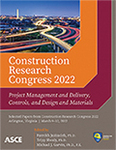Multi-Objective Optimization Model to Minimize Upgrade and Utility Costs of Large Existing Buildings
Publication: Construction Research Congress 2022
ABSTRACT
Energy and water efficiency measures can offer great reduction in utility costs of large existing buildings. However, decision-makers are often faced with a challenging task to identify the most cost effective measures within available budgets due to wide variety of energy and water efficiency measures. This paper presents the development of a new model that is capable of identifying optimum trade-offs between (1) minimizing upgrade cost, and (2) minimizing utility cost of existing buildings simultaneously while maintaining building operational performance. To this end, a multi-objective model is developed in three main steps: (1) formulation step where decision variables, objective function, and constraints are identified and formulated; (2) implementation step that performs the model computations and specifies the model input and output data; and (3) performance evaluation step where a case study is analyzed to evaluate the performance of the model. The primary contributions that this research adds to existing are (1) development of a new optimization model that can identify optimal building upgrades to strike a balance between upgrade cost and utility cost, and (2) implementing the model computations using epsilon-constraint method and binary linear programming to guarantee the optimality of the generated solution in short computational time. The case study results illustrated that the developed model was able to identify pareto-optimal solutions of the two optimization objectives and optimal set of upgrade measures for each of the pareto-optimal solutions for a study period of 20 years that reduced utility costs up to 39.5%.
Get full access to this article
View all available purchase options and get full access to this chapter.
REFERENCES
Abdallah, M., El-Rayes, K., and Liu, L. (2016). “Economic and GHG Emission Analysis of Implementing Sustainable Measures in Existing Public Buildings.” 30(6).
Bertone, E., Stewart, R. A., Sahin, O., Alam, M., Zou, P. X. W., Buntine, C., and Marshall, C. (2018). “Guidelines, barriers and strategies for energy and water retrofits of public buildings.” Journal of Cleaner Production, Elsevier Ltd, 174, 1064–1078.
Carlsson, M., Touchie, M., and Richman, R. (2019). “Investigating the potential impact of a compartmentalization and ventilation system retrofit strategy on energy use in high-rise residential buildings.” Energy and Buildings, Elsevier B.V., 199, 20–28.
Delgarm, N., Sajadi, B., Kowsary, F., and Delgarm, S. (2016). “Multi-objective optimization of the building energy performance: A simulation-based approach by means of particle swarm optimization (PSO).” Applied Energy, Elsevier Ltd, 170, 293–303.
Ehrgott, M. (2005). Multicriteria optimization: Second edition. Multicriteria Optimization: Second Edition.
Evin, D., and Ucar, A. (2019). “Energy impact and eco-e ffi ciency of the envelope insulation in residential buildings in Turkey.” Applied Thermal Engineering, Elsevier, 154(December 2018), 573–584.
Haimes, Y. Y., Lasdon, L. S., and Wismer, D. A. (1971). “On a bicriterion formulation of the problems of integrated identification and system optimization.” IEEE Transactions on Systems, Man and Cybernetics, SMC-1(3).
Hutchison, S., Ghafoori, M., Abdallah, M., and Clevenger, C. (2019). “Optimizing selection of building materials and fixtures to reduce operational costs.” Proceedings, Annual Conference - Canadian Society for Civil Engineering.
Kumar, N. M., and Mathew, M. (2018). “Comparative life-cycle cost and GHG emission analysis of five different water heating systems for residential buildings in Australia.” Beni-Suef University Journal of Basic and Applied Sciences, Elsevier B.V., 7(4), 748–751.
Lepinski, L., Freitas, G., Henning, E., Kalbusch, A., Cristina, A., Maria, O., and Carvalho, F. (2019). “Analysis of water consumption in toilets employing Shewhart, EWMA, and Shewhart-EWMA combined control charts.” Journal of Cleaner Production, Elsevier Ltd, 233, 1146–1157.
Litti, G., Audenaert, A., and Lavagna, M. (2020). “Life cycle operating energy saving from windows retro fi tting in heritage buildings accounting for technical performance decay.” Journal of Building Engineering, Elsevier Ltd, 17(December 2017), 135–153.
Magno, M., Polonelli, T., Benini, L., and Popovici, E. (2015). “A low cost, highly scalable wireless sensor network solution to achieve smart LED light control for green buildings.” IEEE Sensors Journal, Institute of Electrical and Electronics Engineers Inc., 15(5), 2963–2973.
Mostavi, E., Asadi, S., and Boussaa, D. (2017). “Development of a new methodology to optimize building life cycle cost, environmental impacts, and occupant satisfaction.” Energy, Elsevier Ltd, 121, 606–615.
NREL. (2020). “OpenStudio | OpenStudio.” OpenStudio, <https://www.openstudio.net/>(May 19, 2021).
Rabani, M., Bayera Madessa, H., Mohseni, O., and Nord, N. (2020). “Minimizing delivered energy and life cycle cost using Graphical script: An office building retrofitting case.” Applied Energy, Elsevier, 268(March), 114929.
Rosso, F., Ciancio, V., Dell’Olmo, J., and Salata, F. (2020). “Multi-objective optimization of building retrofit in the Mediterranean climate by means of genetic algorithm application.” Energy and Buildings, Elsevier B.V., 216, 109945.
RSMeans. (2020). 2020 Building Construction Costs Book. (P. R. Waier, ed.), RSMeans.
Sharif, S. A., and Hammad, A. (2019). “Simulation-Based Multi-Objective Optimization of institutional building renovation considering energy consumption, Life-Cycle Cost and Life-Cycle Assessment.” Journal of Building Engineering, Elsevier Ltd, 21(June 2018), 429–445.
Sofos, M., Langevin, J., Deru, M., Gupta, E., Benne, K. S., Blum, D., Bohn, T., Fares, R., Fernandez, N., Fink, G., and Frank, S. (2020). “Innovations in sensors and controls for building energy management: Research and development opportunities report for emerging technologies.” (February).
USGBC (U.S. Green Building Council). (2018). LEED v4 for Building Operation and Maintenance.” U.S. Green Building Council.
Yuan, J., Nian, V., and Su, B. (2019). “Evaluation of cost-effective building retrofit strategies through soft-linking a metamodel-based Bayesian method and a life cycle cost assessment method.” Applied Energy, Elsevier, 253(July), 113573.
Zhivov, A., and Lohse, R. (2021). “What is Deep Energy Retrofit?” SpringerBriefs in Applied Sciences and Technology.
Information & Authors
Information
Published In
History
Published online: Mar 7, 2022
Authors
Metrics & Citations
Metrics
Citations
Download citation
If you have the appropriate software installed, you can download article citation data to the citation manager of your choice. Simply select your manager software from the list below and click Download.
